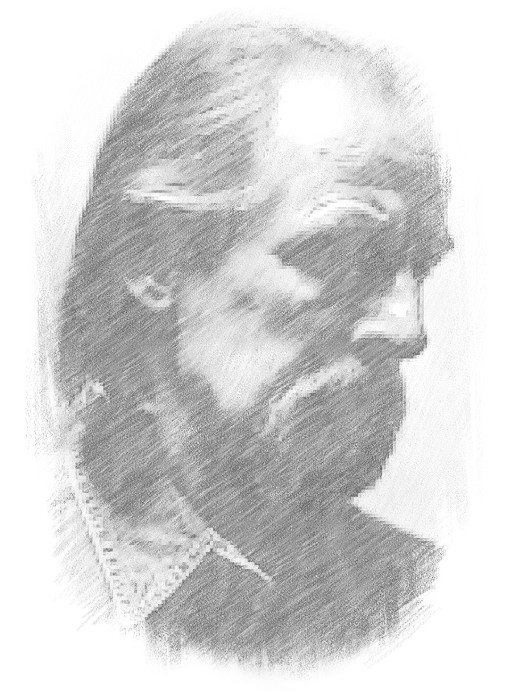
Paul Pletka
(b.1946)
Born in San Diego and educated at Arizona State University in Phoenix and Colorado State University in Fort Collins, Paul Pletka has spent his life painting the subject that most fascinates – Native Americans. In an interview with Art Talka, Pletka said “When I was a youngster and first became enchanted with Indian costume, lore and artifacts, I would sometimes pretend I was an Indian. I soon realized that was not intellectually reasonable. I am not an Indian. I am simply an interpreter.”
Despite his humble words, Pletka is regarded by the art world as well as many Native Americans as quite simply – one of the best. His paintings have been exhibited in one-man shows throughout Arizona, Colorado, New Mexico and Texas as well as Chicago and New York continuously since 1964. Pletka’s works grace more than 40 private and public art collections including the Albuquerque Art Museum, the Texas Museum of Art and the United States Department of the Interior in Washington, D.C..
Interestingly enough, Pletka has never taken a painting course. His focus in college was printmaking. Through an extensive process of experimentation, he refined his technique and works in a style considered by experts as Neo-Surrealism. His heroic-sized visions of Indian mysticism are distinguished by exacting details that can only be achieved when technique is coupled with dedicated research.
Source: Art Fortune
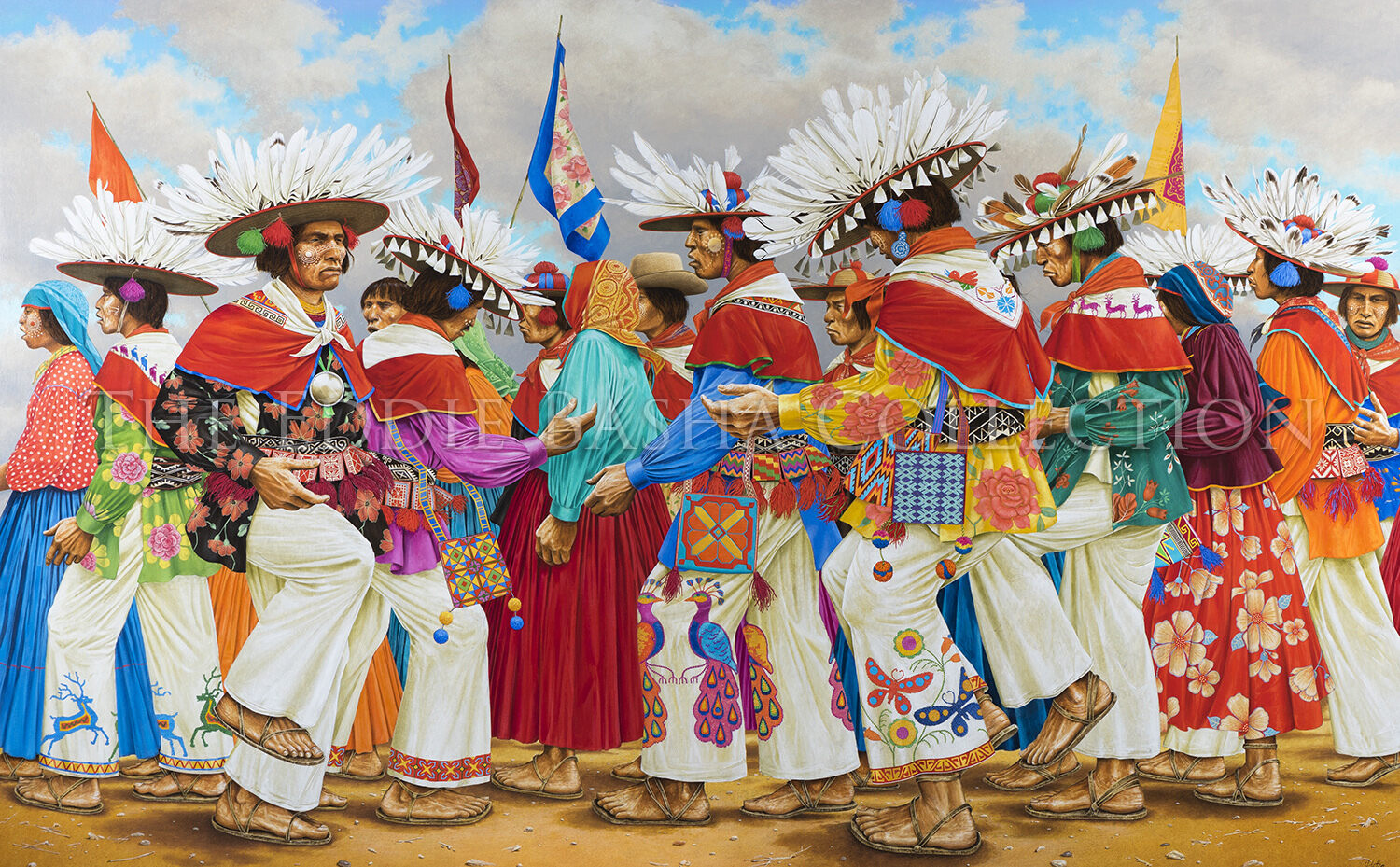
Danza Mitote, Los Huicholes
Artist: Paul Pletka (b.1946)
Description: Acrylic on Linen (2005) | Dimensions: 60”h x 96”w; Mounted on Stretcher Barspainting
The Huichols are a small tribe of approximately 35,000 living in central western Mexico in the Sierra Madre Mountains who maintain their pre-Columbian traditions. The “Danza Mitote” is a religious festival of the Huichols. In this depiction, the artist captures the rhythmic movement, color and motion of the dancing figures dressed in traditional clothing. The hats worn by the males are hand-woven sombreros decorated with white turkey feathers and paper pendants suspended from the brims. The men wear pants of handspun white cotton, decorated with yarn embroidery. The women wear flowing skirts and blouses of bright trade cloth with traditional head cloths. Visual references to peyote are in all the hexagonal designs found in the clothing and accoutrements, such as the woven bags, of the dancers.
The artist, Paul Pletka, has a style that is truly unique, one that sets him apart from other artists who have explored themes of indigenous people around the world. Often favoring bright, glowing colors, he creates scenes of rituals and ceremonies that have movement, vibrancy, and a dynamic flow. Although a realistic artist, albeit one influenced by surrealism and abstract expressionism, Pletka often exaggerates the features of his subjects, such as their hands, feet, or faces, to enhance their individualism and cultural identification. The vibrant swirls of color in this large piece heightens the viewer’s experience to that of a bystander connecting to the rhythm of the dance as well as the dancers themselves.
Pletka’s work can be found in museums and private collections worldwide.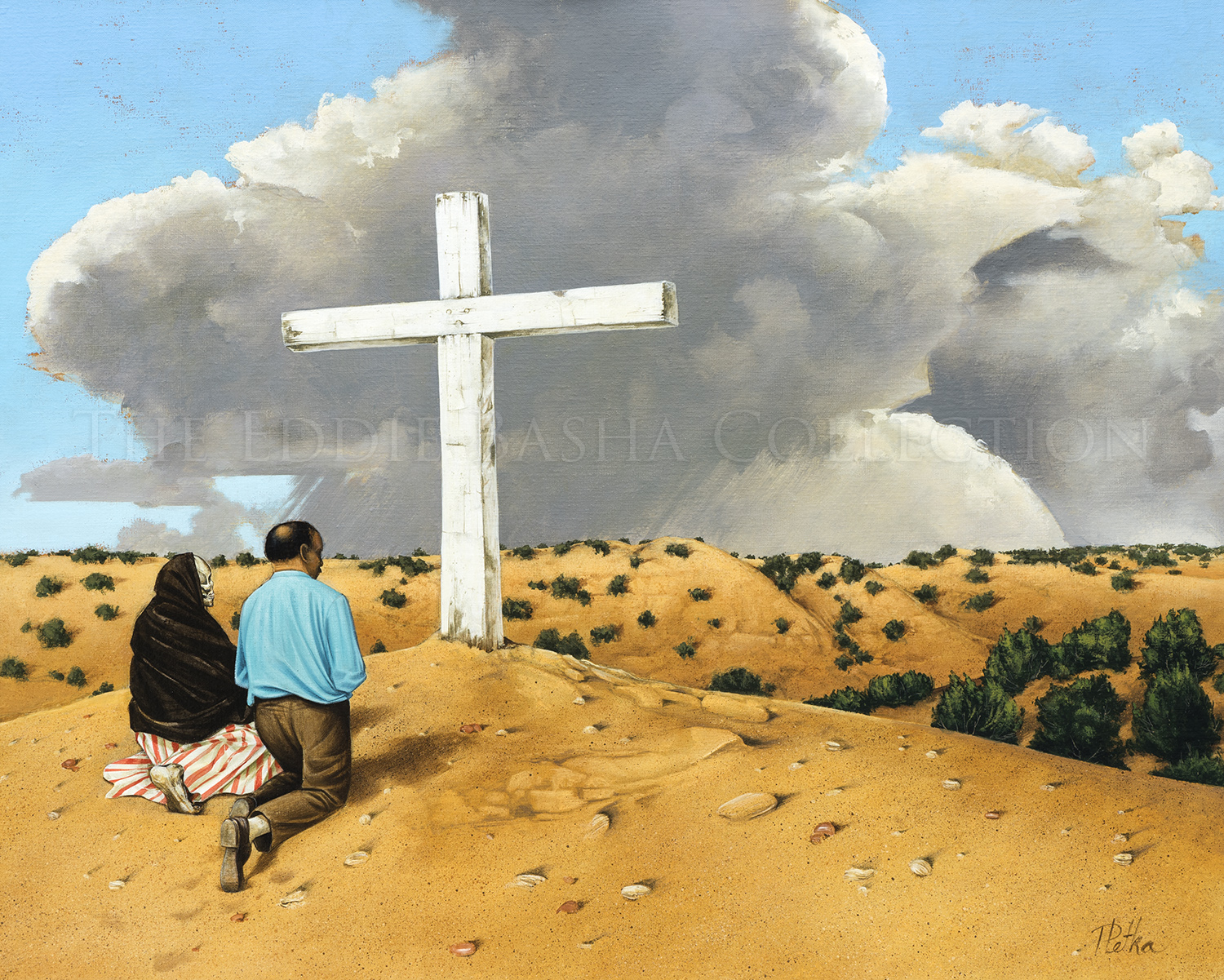
The Silent Partner
Artist: Paul Pletka (b.1946)
Description: Acrylic on Canvas (1999) | Image Size: 24”h x 30”w; Mounted on Stretcher Barspainting
In this painting of two figures kneeling before a cross in the desert beneath a roiling storm cloud, Paul Pletka captures beautifully the mysticism, spirituality and stark desert beauty of the New Mexico landscape.
The figure to the left of the kneeling man is Dona Sebastiana, the female personification of death who represents and commends mortal souls and even bestows blessings. In Northern New Mexico and Southern Colorado she is honored particularly amongst the Los Hermanos Penitentes, the roots of which date back approximately eight hundred years to Spain and Italy where members would practice self-flagellation and other forms of physical torment as penance for their sins. The Penitentes have been in New Mexico for over 400 years and today act predominantly as a charitable and beneficent organization within their communities.
An image of “The Silent Partner” appears in the book entitled “Paul Pletka Imagined Wests”, authored by Amy Scott, Autry Museum, with contributions by Paul Pletka and foreword by James K. Ballinger, former Executive Director of the Phoenix Art Museum, published by University of Oklahoma Press in 2017. It was also featured in the “Paul Pletka: Converging Faiths in the New World” exhibition at the Museum of Spanish Colonial Art in 2019.
El Encuentro
Artist: Paul Pletka (b.1946)
Description: Acrylic on Canvas (1999) | Image Size: 72”h x 72”w; mounted on stretcher bars/unframedpainting
In this large masterwork, an annual Easter ritual practiced by the Penitente, a group known for its strict adherence to decades old traditions, is depicted. Here, the men and women of the church are carrying bultos, three-dimensional wooden sculptures, of Jesus and Mary. At the churchyard, the two groups of mourners approach each other led by the elevated bultos. The Penitente brothers carry the large statue of Jesus; they sing traditional songs and recite prayers while they accompany the condemned son on his sad journey to say goodbye to Mary. At the critical moment of encounter, the bultos are tipped slightly towards each other in a final gesture of farewell.
The artist, Paul Pletka, has a distinctive style that is immediately recognizable. His figures are quite realistic, but often with exaggerated specific elements, such as the hands or face. He is a student of both American Indian history and the traditions of the Hispanic culture of Northern New Mexico. “El Encuentro” was purchased from the Riva Yares Gallery in Santa Fe, New Mexico, and subsequently loaned in 2019 to the Museum of Spanish Colonial Art, also in Santa Fe, for the exhibition entitled “Paul Pletka: Converging Faiths in the New World.”
Mountain Man
Artist: Paul Pletka (b.1946)
Description: Lithographic Crayon (1975) | Image Size: 38”h x 25”w; Framed Size: 50 ¾”h x 37 7/8”wdrawing
Occasionally when there isn’t a clue regarding a particular piece in the collection, we’ll communicate with the artist. In this instance, we did just that. Paul Pletka indicated that he hadn’t thought about this piece for several years. He recalled, however, that it may have been of a particular mountain man friend. The artist’s wife added that a friend of hers swore he was the most fun boyfriend ever! Case in point, there’s more to the story than meets the eye!
Names were removed to protect the innocent; there will be no kissing and telling here.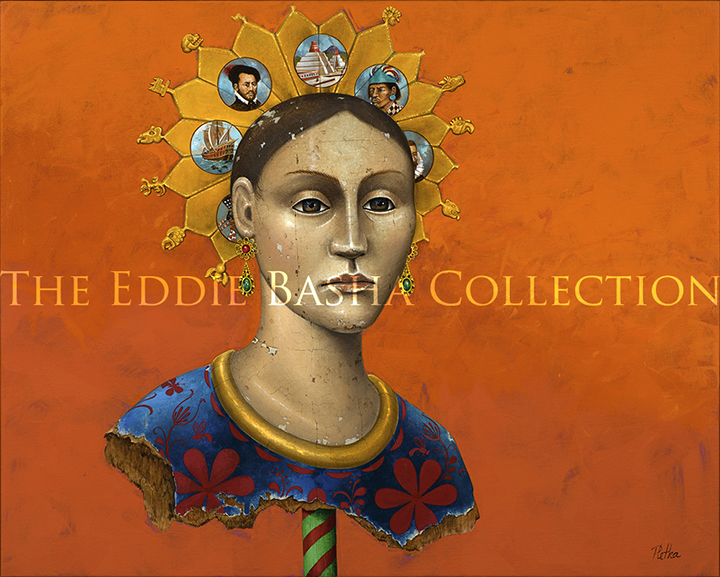
Our Lady of Fate
Artist: Paul Pletka (b.1946)
Description: Acrylic on Canvas (2000) | Image Size: 24”h x 30”w; Framed Size: 25¼”h x 31 ¼”wpainting
The painting is part of a series the artist did on fractured sculptures that illustrated syncretism, or amalgamation, between indigenous peoples of Mexico and Spanish Catholics. She is, of course, a Madonna.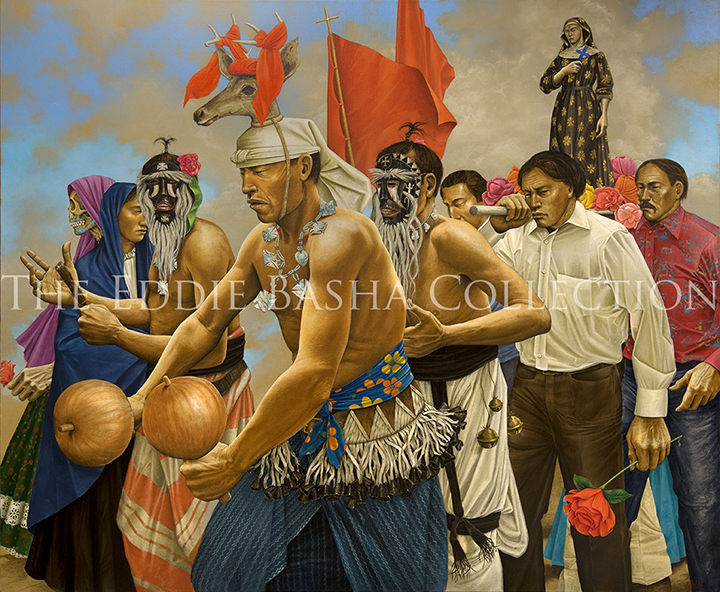
Las Flores Sagradas
Artist: Paul Pletka (b.1946)
Description: Acrylic on Canvas (2000) | Image Size: 64”h x 78”w; Mounted on Stretcher Barspainting
“Las Flores Sagradas” is the finale of Lenten celebrations of the Yaqui people. The central figure is the Deer Dancer, Venado. His belt is woven leather with hoof dangles, his deer headdress is stuffed with grass and its antlers festooned with a red handkerchief. The red cloth represents a flower. The two old men flanking the deer are Pascolas, old men of the desert. These men function as clowns and are intercessors with the “strange and hostile” areas outside of the village. Each wears a flower in his topknot. Flowers are thought to have such positive power that during Easter pageants flower petals are the weapons of choice used to repel the Fariseos when they attack the village church.
The men behind are carrying a bulto of the village saint, in this case Santa Rita de Cascia. She is associated with roses and is the patroness of impossible causes. Paper flowers are strewn on her litter, or anda. Preceding the company is a skeletal figure with a turquoise mosaic on her chin. The markings identify her as Quetzal-flower, the Aztec Goddess of Beauty. The strong Aztec flower imagery association combined with similar Yaqui language and customs makes Quetzal-Flower a Yaqui antecedent, reaching back through time. Quetzal-Flower also appears on the pink shirt of the left-hand figure.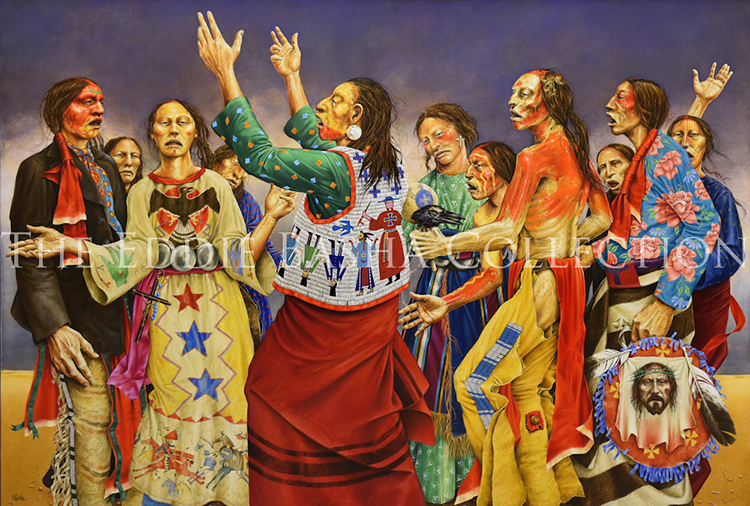
The Father is Coming and the Earth Will Shake
Artist: Paul Pletka (b.1946)
Description: Acrylic on Linen | Image Size: 52”h x 76”w; Framed Size: 53 ¾”h x 77 ¾”wpainting
In “The Father is Coming and the Earth Will Shake”, New Mexico Artist, Paul Pletka, depicts a ghost dance which started as a reaction to incarceration on reservations. Its prophet was Jack Wilson, a Paiute from Pyramid Lake, Nevada, who had a dream and produced a mystical religion in which white people disappeared and the Native Ancestors returned from the dead. The Plains Indians went by train to visit him and “brought the word back” to the reservations.
Here one of the ancestors is coming back from the dead. He’s holding a rattle with a raven head attached and a turtle image on the rattle. The turtle represents the rolling over of the earth and renewal. The raven represents the intercessor with the great spirit. He is wearing the sacred red paint as are most of the dancers. The man on his right with the flowered shirt is holding a Ghost Dance shield on which the apparition of Jesus is appearing. Jack Wilson was a Christian and crucifixion mythology must have influenced his thoughts. Christian symbolism appears again on the beaded vest of the central dancer. The middle red figure is a padre holding a peace pipe which was a Ghost Dance symbol. Under this “protection” is a Native but the figures to the left are upside down white men, showing that they have been killed. The woman next to him is wearing a Ghost Dance dress and belt with crucifix. The eagle painted on the top of the dress is showing power signs radiating from his talon down the dress. On the sleeves are hands, showing the stigmata. The stars running down her dress spread the power from the eagle to the people below. The other dancers are all in a reverie in which exhaustion and euphoria encourage visions of a return to a life without the humiliation and defeat of their current existence.
 Acrylic on Linen (2005) | Dimensions: 60”h x 96”w; Mounted on Stretcher Bars
Acrylic on Linen (2005) | Dimensions: 60”h x 96”w; Mounted on Stretcher Bars The Huichols are a small tribe of approximately 35,000 living in central western Mexico in the Sierra Madre Mountains who maintain their pre-Columbian traditions. The “Danza Mitote” is a religious festival of the Huichols. In this depiction, the artist captures the rhythmic movement, color and motion of the dancing figures dressed in traditional clothing. The hats worn by the males are hand-woven sombreros decorated with white turkey feathers and paper pendants suspended from the brims. The men wear pants of handspun white cotton, decorated with yarn embroidery. The women wear flowing skirts and blouses of bright trade cloth with traditional head cloths. Visual references to peyote are in all the hexagonal designs found in the clothing and accoutrements, such as the woven bags, of the dancers.
The artist, Paul Pletka, has a style that is truly unique, one that sets him apart from other artists who have explored themes of indigenous people around the world. Often favoring bright, glowing colors, he creates scenes of rituals and ceremonies that have movement, vibrancy, and a dynamic flow. Although a realistic artist, albeit one influenced by surrealism and abstract expressionism, Pletka often exaggerates the features of his subjects, such as their hands, feet, or faces, to enhance their individualism and cultural identification. The vibrant swirls of color in this large piece heightens the viewer’s experience to that of a bystander connecting to the rhythm of the dance as well as the dancers themselves.
Pletka’s work can be found in museums and private collections worldwide.
Danza Mitote, Los Huicholes
Artist: Paul Pletka (b.1946)
The Huichols are a small tribe of approximately 35,000 living in central western Mexico in the Sierra Madre Mountains who maintain their pre-Columbian traditions. The “Danza Mitote” is a religious festival of the Huichols. In this depiction, the artist captures the rhythmic movement, color and motion of the dancing figures dressed in traditional clothing. The hats worn by the males are hand-woven sombreros decorated with white turkey feathers and paper pendants suspended from the brims. The men wear pants of handspun white cotton, decorated with yarn embroidery. The women wear flowing skirts and blouses of bright trade cloth with traditional head cloths. Visual references to peyote are in all the hexagonal designs found in the clothing and accoutrements, such as the woven bags, of the dancers.
The artist, Paul Pletka, has a style that is truly unique, one that sets him apart from other artists who have explored themes of indigenous people around the world. Often favoring bright, glowing colors, he creates scenes of rituals and ceremonies that have movement, vibrancy, and a dynamic flow. Although a realistic artist, albeit one influenced by surrealism and abstract expressionism, Pletka often exaggerates the features of his subjects, such as their hands, feet, or faces, to enhance their individualism and cultural identification. The vibrant swirls of color in this large piece heightens the viewer’s experience to that of a bystander connecting to the rhythm of the dance as well as the dancers themselves.
Pletka’s work can be found in museums and private collections worldwide.
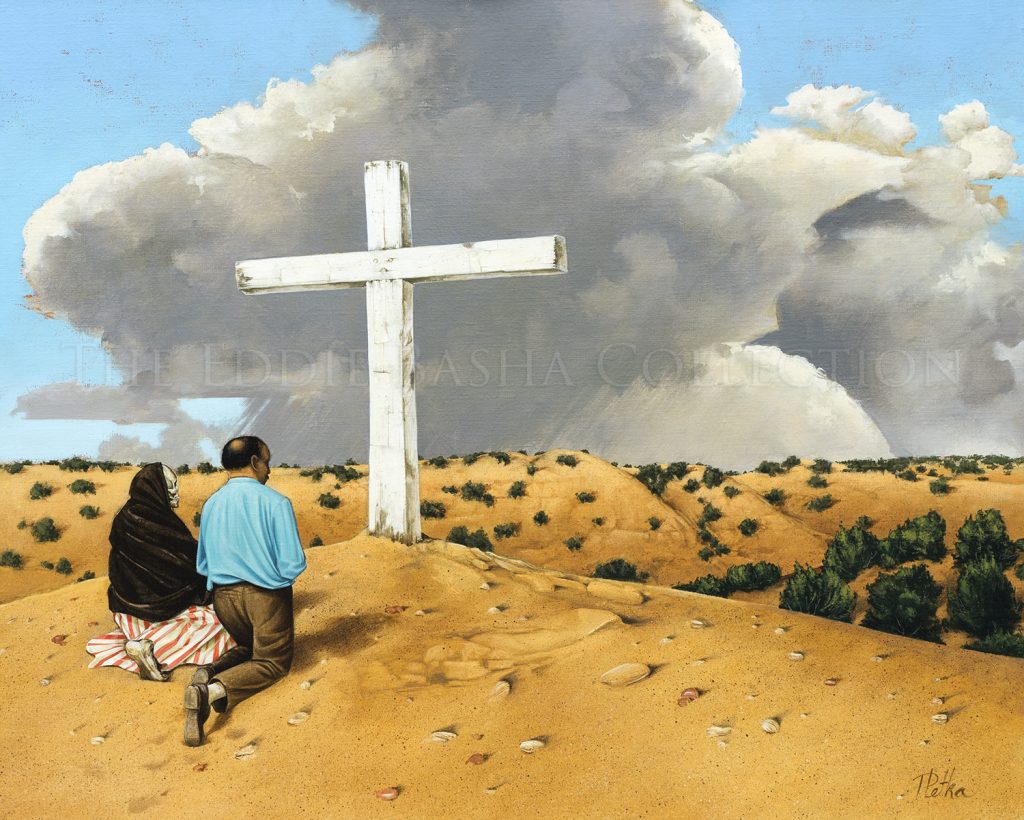 Acrylic on Canvas (1999) | Image Size: 24”h x 30”w; Mounted on Stretcher Bars
Acrylic on Canvas (1999) | Image Size: 24”h x 30”w; Mounted on Stretcher BarsIn this painting of two figures kneeling before a cross in the desert beneath a roiling storm cloud, Paul Pletka captures beautifully the mysticism, spirituality and stark desert beauty of the New Mexico landscape.
The figure to the left of the kneeling man is Dona Sebastiana, the female personification of death who represents and commends mortal souls and even bestows blessings. In Northern New Mexico and Southern Colorado she is honored particularly amongst the Los Hermanos Penitentes, the roots of which date back approximately eight hundred years to Spain and Italy where members would practice self-flagellation and other forms of physical torment as penance for their sins. The Penitentes have been in New Mexico for over 400 years and today act predominantly as a charitable and beneficent organization within their communities.
An image of “The Silent Partner” appears in the book entitled “Paul Pletka Imagined Wests”, authored by Amy Scott, Autry Museum, with contributions by Paul Pletka and foreword by James K. Ballinger, former Executive Director of the Phoenix Art Museum, published by University of Oklahoma Press in 2017. It was also featured in the “Paul Pletka: Converging Faiths in the New World” exhibition at the Museum of Spanish Colonial Art in 2019.
The Silent Partner
Artist: Paul Pletka (b.1946)
In this painting of two figures kneeling before a cross in the desert beneath a roiling storm cloud, Paul Pletka captures beautifully the mysticism, spirituality and stark desert beauty of the New Mexico landscape.
The figure to the left of the kneeling man is Dona Sebastiana, the female personification of death who represents and commends mortal souls and even bestows blessings. In Northern New Mexico and Southern Colorado she is honored particularly amongst the Los Hermanos Penitentes, the roots of which date back approximately eight hundred years to Spain and Italy where members would practice self-flagellation and other forms of physical torment as penance for their sins. The Penitentes have been in New Mexico for over 400 years and today act predominantly as a charitable and beneficent organization within their communities.
An image of “The Silent Partner” appears in the book entitled “Paul Pletka Imagined Wests”, authored by Amy Scott, Autry Museum, with contributions by Paul Pletka and foreword by James K. Ballinger, former Executive Director of the Phoenix Art Museum, published by University of Oklahoma Press in 2017. It was also featured in the “Paul Pletka: Converging Faiths in the New World” exhibition at the Museum of Spanish Colonial Art in 2019.
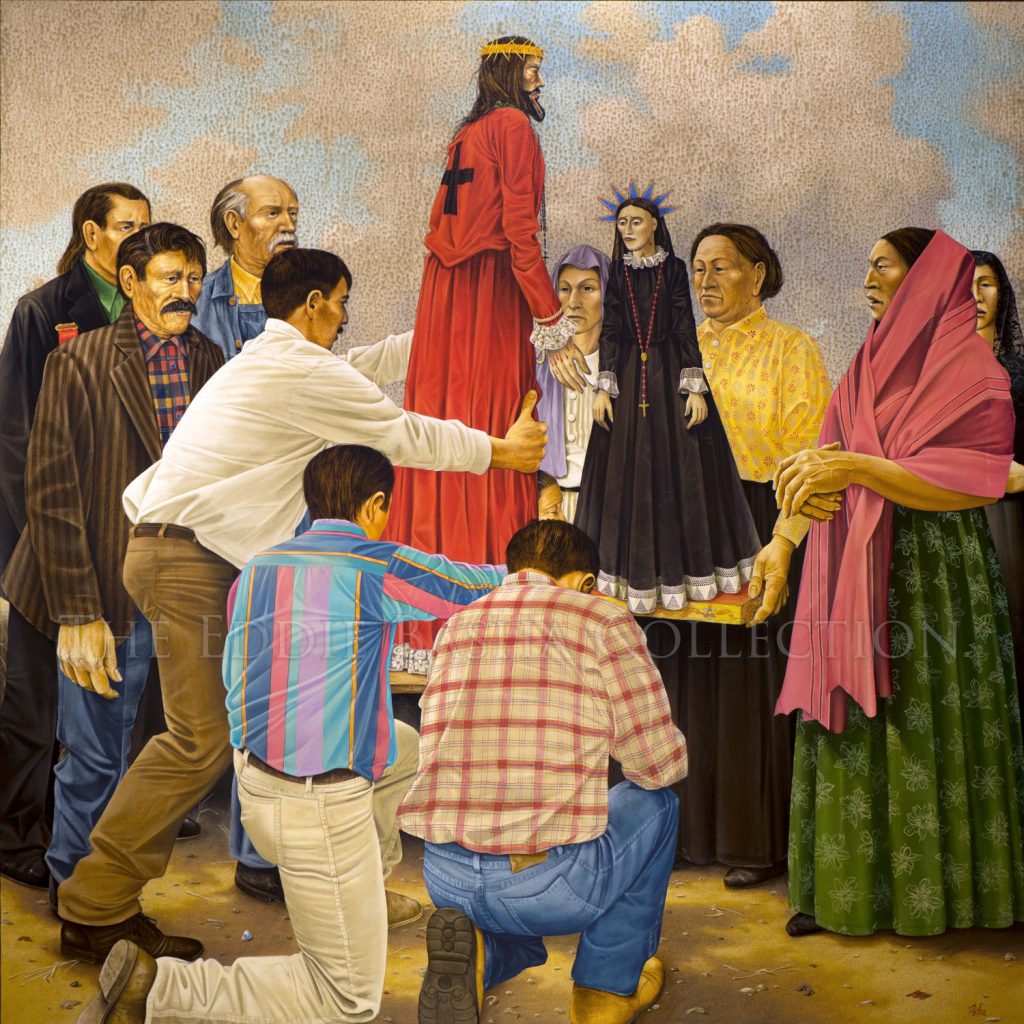 Acrylic on Canvas (1999) | Image Size: 72”h x 72”w; mounted on stretcher bars/unframed
Acrylic on Canvas (1999) | Image Size: 72”h x 72”w; mounted on stretcher bars/unframed In this large masterwork, an annual Easter ritual practiced by the Penitente, a group known for its strict adherence to decades old traditions, is depicted. Here, the men and women of the church are carrying bultos, three-dimensional wooden sculptures, of Jesus and Mary. At the churchyard, the two groups of mourners approach each other led by the elevated bultos. The Penitente brothers carry the large statue of Jesus; they sing traditional songs and recite prayers while they accompany the condemned son on his sad journey to say goodbye to Mary. At the critical moment of encounter, the bultos are tipped slightly towards each other in a final gesture of farewell.
The artist, Paul Pletka, has a distinctive style that is immediately recognizable. His figures are quite realistic, but often with exaggerated specific elements, such as the hands or face. He is a student of both American Indian history and the traditions of the Hispanic culture of Northern New Mexico. “El Encuentro” was purchased from the Riva Yares Gallery in Santa Fe, New Mexico, and subsequently loaned in 2019 to the Museum of Spanish Colonial Art, also in Santa Fe, for the exhibition entitled “Paul Pletka: Converging Faiths in the New World.”
El Encuentro
Artist: Paul Pletka (b.1946)
In this large masterwork, an annual Easter ritual practiced by the Penitente, a group known for its strict adherence to decades old traditions, is depicted. Here, the men and women of the church are carrying bultos, three-dimensional wooden sculptures, of Jesus and Mary. At the churchyard, the two groups of mourners approach each other led by the elevated bultos. The Penitente brothers carry the large statue of Jesus; they sing traditional songs and recite prayers while they accompany the condemned son on his sad journey to say goodbye to Mary. At the critical moment of encounter, the bultos are tipped slightly towards each other in a final gesture of farewell.
The artist, Paul Pletka, has a distinctive style that is immediately recognizable. His figures are quite realistic, but often with exaggerated specific elements, such as the hands or face. He is a student of both American Indian history and the traditions of the Hispanic culture of Northern New Mexico. “El Encuentro” was purchased from the Riva Yares Gallery in Santa Fe, New Mexico, and subsequently loaned in 2019 to the Museum of Spanish Colonial Art, also in Santa Fe, for the exhibition entitled “Paul Pletka: Converging Faiths in the New World.”
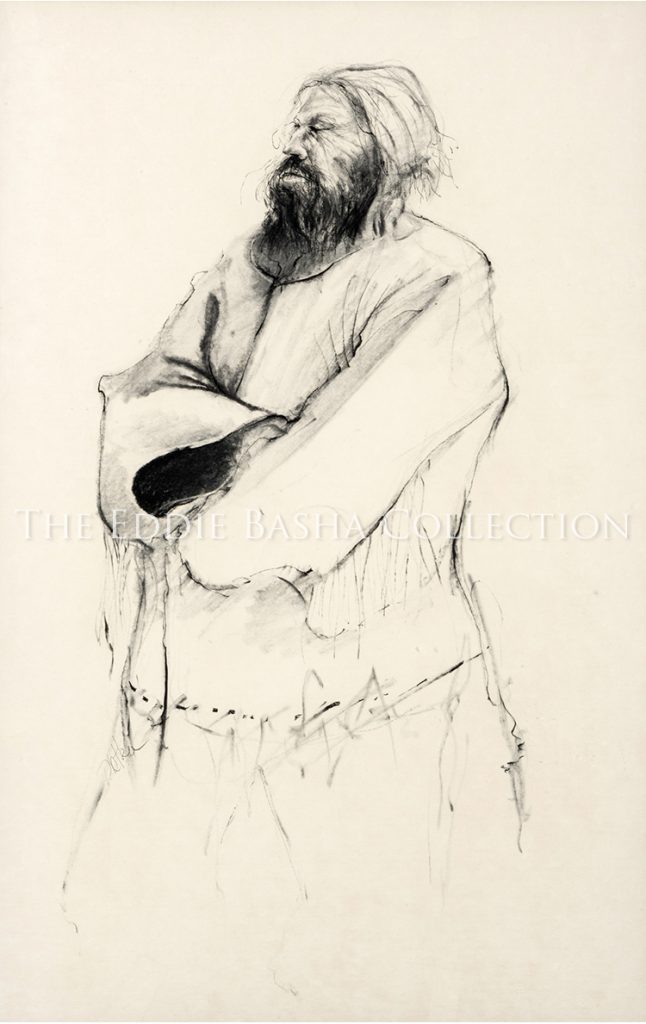 Lithographic Crayon (1975) | Image Size: 38”h x 25”w; Framed Size: 50 ¾”h x 37 7/8”w
Lithographic Crayon (1975) | Image Size: 38”h x 25”w; Framed Size: 50 ¾”h x 37 7/8”wOccasionally when there isn’t a clue regarding a particular piece in the collection, we’ll communicate with the artist. In this instance, we did just that. Paul Pletka indicated that he hadn’t thought about this piece for several years. He recalled, however, that it may have been of a particular mountain man friend. The artist’s wife added that a friend of hers swore he was the most fun boyfriend ever! Case in point, there’s more to the story than meets the eye!
Names were removed to protect the innocent; there will be no kissing and telling here.
Mountain Man
Artist: Paul Pletka (b.1946)
Occasionally when there isn’t a clue regarding a particular piece in the collection, we’ll communicate with the artist. In this instance, we did just that. Paul Pletka indicated that he hadn’t thought about this piece for several years. He recalled, however, that it may have been of a particular mountain man friend. The artist’s wife added that a friend of hers swore he was the most fun boyfriend ever! Case in point, there’s more to the story than meets the eye!
Names were removed to protect the innocent; there will be no kissing and telling here.
 Acrylic on Canvas (2000) | Image Size: 24”h x 30”w; Framed Size: 25¼”h x 31 ¼”w
Acrylic on Canvas (2000) | Image Size: 24”h x 30”w; Framed Size: 25¼”h x 31 ¼”wThe painting is part of a series the artist did on fractured sculptures that illustrated syncretism, or amalgamation, between indigenous peoples of Mexico and Spanish Catholics. She is, of course, a Madonna.
Our Lady of Fate
Artist: Paul Pletka (b.1946)
The painting is part of a series the artist did on fractured sculptures that illustrated syncretism, or amalgamation, between indigenous peoples of Mexico and Spanish Catholics. She is, of course, a Madonna.
 Acrylic on Canvas (2000) | Image Size: 64”h x 78”w; Mounted on Stretcher Bars
Acrylic on Canvas (2000) | Image Size: 64”h x 78”w; Mounted on Stretcher Bars “Las Flores Sagradas” is the finale of Lenten celebrations of the Yaqui people. The central figure is the Deer Dancer, Venado. His belt is woven leather with hoof dangles, his deer headdress is stuffed with grass and its antlers festooned with a red handkerchief. The red cloth represents a flower. The two old men flanking the deer are Pascolas, old men of the desert. These men function as clowns and are intercessors with the “strange and hostile” areas outside of the village. Each wears a flower in his topknot. Flowers are thought to have such positive power that during Easter pageants flower petals are the weapons of choice used to repel the Fariseos when they attack the village church.
The men behind are carrying a bulto of the village saint, in this case Santa Rita de Cascia. She is associated with roses and is the patroness of impossible causes. Paper flowers are strewn on her litter, or anda. Preceding the company is a skeletal figure with a turquoise mosaic on her chin. The markings identify her as Quetzal-flower, the Aztec Goddess of Beauty. The strong Aztec flower imagery association combined with similar Yaqui language and customs makes Quetzal-Flower a Yaqui antecedent, reaching back through time. Quetzal-Flower also appears on the pink shirt of the left-hand figure.
Las Flores Sagradas
Artist: Paul Pletka (b.1946)
“Las Flores Sagradas” is the finale of Lenten celebrations of the Yaqui people. The central figure is the Deer Dancer, Venado. His belt is woven leather with hoof dangles, his deer headdress is stuffed with grass and its antlers festooned with a red handkerchief. The red cloth represents a flower. The two old men flanking the deer are Pascolas, old men of the desert. These men function as clowns and are intercessors with the “strange and hostile” areas outside of the village. Each wears a flower in his topknot. Flowers are thought to have such positive power that during Easter pageants flower petals are the weapons of choice used to repel the Fariseos when they attack the village church.
The men behind are carrying a bulto of the village saint, in this case Santa Rita de Cascia. She is associated with roses and is the patroness of impossible causes. Paper flowers are strewn on her litter, or anda. Preceding the company is a skeletal figure with a turquoise mosaic on her chin. The markings identify her as Quetzal-flower, the Aztec Goddess of Beauty. The strong Aztec flower imagery association combined with similar Yaqui language and customs makes Quetzal-Flower a Yaqui antecedent, reaching back through time. Quetzal-Flower also appears on the pink shirt of the left-hand figure.
 Acrylic on Linen | Image Size: 52”h x 76”w; Framed Size: 53 ¾”h x 77 ¾”w
Acrylic on Linen | Image Size: 52”h x 76”w; Framed Size: 53 ¾”h x 77 ¾”w In “The Father is Coming and the Earth Will Shake”, New Mexico Artist, Paul Pletka, depicts a ghost dance which started as a reaction to incarceration on reservations. Its prophet was Jack Wilson, a Paiute from Pyramid Lake, Nevada, who had a dream and produced a mystical religion in which white people disappeared and the Native Ancestors returned from the dead. The Plains Indians went by train to visit him and “brought the word back” to the reservations.
Here one of the ancestors is coming back from the dead. He’s holding a rattle with a raven head attached and a turtle image on the rattle. The turtle represents the rolling over of the earth and renewal. The raven represents the intercessor with the great spirit. He is wearing the sacred red paint as are most of the dancers. The man on his right with the flowered shirt is holding a Ghost Dance shield on which the apparition of Jesus is appearing. Jack Wilson was a Christian and crucifixion mythology must have influenced his thoughts. Christian symbolism appears again on the beaded vest of the central dancer. The middle red figure is a padre holding a peace pipe which was a Ghost Dance symbol. Under this “protection” is a Native but the figures to the left are upside down white men, showing that they have been killed. The woman next to him is wearing a Ghost Dance dress and belt with crucifix. The eagle painted on the top of the dress is showing power signs radiating from his talon down the dress. On the sleeves are hands, showing the stigmata. The stars running down her dress spread the power from the eagle to the people below. The other dancers are all in a reverie in which exhaustion and euphoria encourage visions of a return to a life without the humiliation and defeat of their current existence.
The Father is Coming and the Earth Will Shake
Artist: Paul Pletka (b.1946)
In “The Father is Coming and the Earth Will Shake”, New Mexico Artist, Paul Pletka, depicts a ghost dance which started as a reaction to incarceration on reservations. Its prophet was Jack Wilson, a Paiute from Pyramid Lake, Nevada, who had a dream and produced a mystical religion in which white people disappeared and the Native Ancestors returned from the dead. The Plains Indians went by train to visit him and “brought the word back” to the reservations.
Here one of the ancestors is coming back from the dead. He’s holding a rattle with a raven head attached and a turtle image on the rattle. The turtle represents the rolling over of the earth and renewal. The raven represents the intercessor with the great spirit. He is wearing the sacred red paint as are most of the dancers. The man on his right with the flowered shirt is holding a Ghost Dance shield on which the apparition of Jesus is appearing. Jack Wilson was a Christian and crucifixion mythology must have influenced his thoughts. Christian symbolism appears again on the beaded vest of the central dancer. The middle red figure is a padre holding a peace pipe which was a Ghost Dance symbol. Under this “protection” is a Native but the figures to the left are upside down white men, showing that they have been killed. The woman next to him is wearing a Ghost Dance dress and belt with crucifix. The eagle painted on the top of the dress is showing power signs radiating from his talon down the dress. On the sleeves are hands, showing the stigmata. The stars running down her dress spread the power from the eagle to the people below. The other dancers are all in a reverie in which exhaustion and euphoria encourage visions of a return to a life without the humiliation and defeat of their current existence.